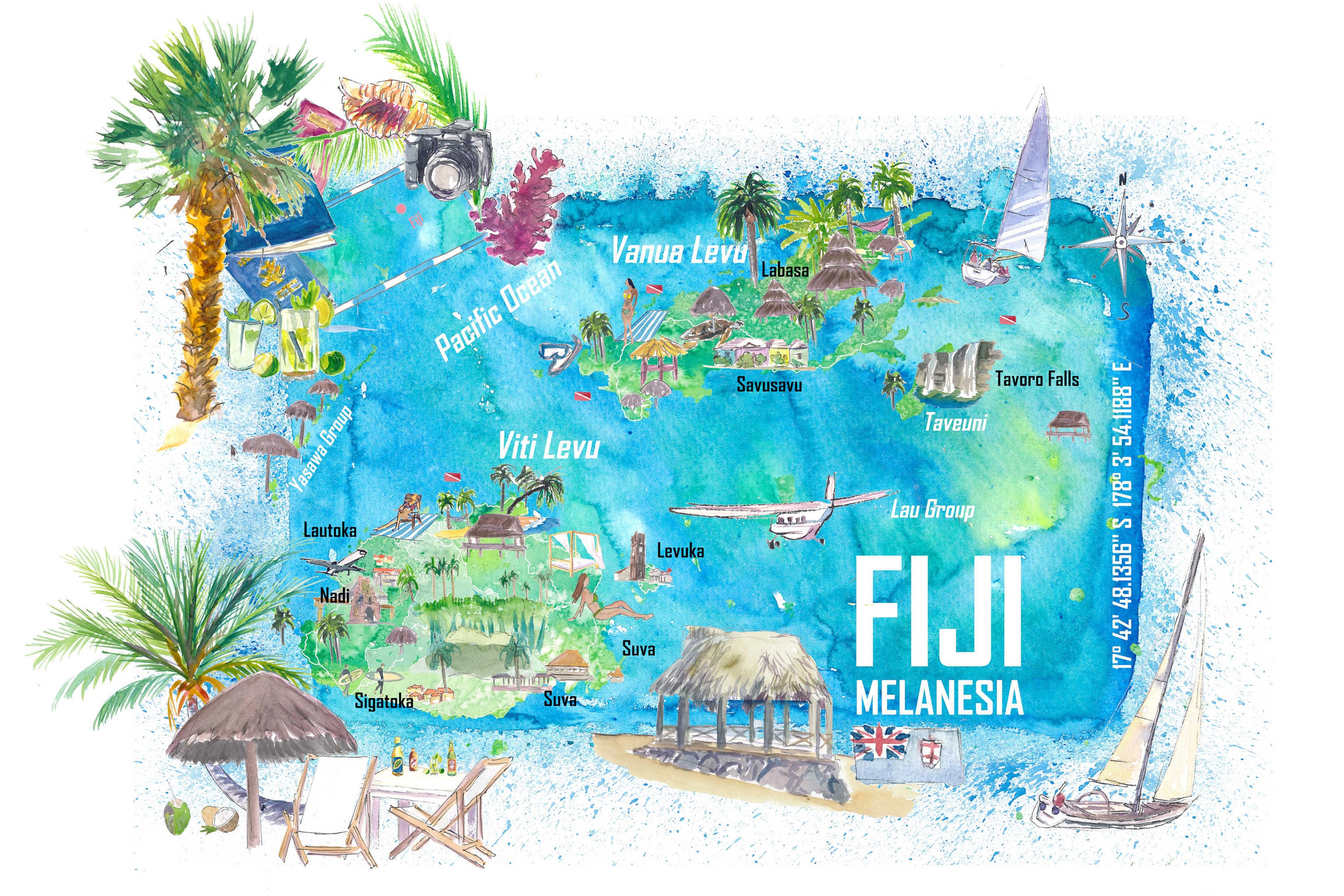
There are few places on Earth where the word for "hello" encapsulates an entire culture. In Fiji, "Bula!" is more than a greeting; it’s a wish for happiness, good health, and life itself. It’s the first word you’ll hear upon arrival and the last one that will echo in your memory, a warm, genuine welcome to a nation of over 300 islands scattered like jewels across the South Pacific.
Fiji is the quintessential tropical paradise—a canvas of impossibly blue waters, swaying coconut palms, and beaches of brilliant white sand. But to define it by its landscape alone is to miss its heart. The true magic of Fiji lies in its people, whose infectious joy and deep-rooted community spirit transform a beautiful destination into an unforgettable experience. This guide will navigate you through everything you need to know to plan your journey to this archipelago of dreams, from its storied past to its vibrant present.
A Glimpse into Fiji’s Rich History

Related Articles about Bula! Your Ultimate Guide to Traveling in Fiji, the Land of a Thousand Smiles:
- Discovering Qatar: A Journey Through History, Luxury, and Adventure
- Australia: A Journey of Wonders, From Cosmopolitan Cities to Untamed Wilderness, And the Hotels That Elevate the Experience
- Vancouver: A Tapestry of Urban Sophistication and Natural Majesty
- Kenya: Where Wildlife Roams and History Whispers
- Chiang Mai: The Rose of the North – An Ultimate Travel Guide
To truly appreciate Fiji, one must understand its fascinating and complex history. The islands’ story is a rich tapestry woven from ancient migrations, fierce tribal warfare, colonial influence, and a resilient spirit. The first inhabitants, the Lapita people, arrived over 3,500 years ago, ancestors of the modern iTaukei (indigenous Fijians). For centuries, a formidable warrior culture flourished, marked by intricate social structures and, famously, ritual cannibalism—a practice that earned Fiji the moniker "the Cannibal Isles."
European contact began in the 17th century with Dutch explorer Abel Tasman, but it wasn’t until the 19th century that whalers, traders, and missionaries began to arrive in significant numbers. The lucrative trade in sandalwood and sea cucumbers led to intense tribal conflicts, armed with European muskets. Seeking stability, the powerful chief Ratu Seru Epenisa Cakobau ceded the islands to the British Crown in 1874.
Under British rule, the colonial government established vast sugarcane plantations but, seeking to protect the iTaukei way of life, prohibited them from being used as laborers. Instead, they brought in indentured workers from India between 1879 and 1916. This single policy profoundly shaped modern Fiji, creating a multicultural society where the Indo-Fijian population now comprises nearly 40% of the nation.
Fiji gained independence in 1970, and its journey as a sovereign nation has been marked by both progress and political challenges. Today, this history is visible everywhere: in the diverse faces of its people, the spicy notes of a Fijian-Indian curry, and the deep respect for tradition and community (vanua) that underpins daily life.
When to Go: Finding Your Perfect Fijian Season
Fiji enjoys a warm, tropical climate year-round, but it’s defined by two distinct seasons.
- The Dry Season (May to October): This is Fiji’s winter and the peak tourist season. You can expect sun-drenched days, lower humidity, and minimal rainfall. Temperatures hover comfortably between 20°C and 29°C (68°F to 84°F). It’s the ideal time for weddings, diving, hiking, and any activity where clear skies are paramount. The trade-off is higher prices for flights and accommodation, and more crowded resorts.
- The Wet Season (November to April): Also known as the "green season," this period brings higher humidity, warmer temperatures (up to 33°C or 91°F), and short, intense tropical downpours, usually in the afternoon. While there’s a risk of cyclones (especially from January to March), it’s also a time of lush, vibrant landscapes, spectacular sunsets, and fewer tourists. This season is perfect for budget-conscious travelers, as deals on resorts and tours are plentiful.

For a happy medium, consider the shoulder months of April, May, October, and November, which often offer a pleasant balance of good weather, fewer crowds, and more reasonable prices.
Getting There and Around: Navigating Paradise
Getting to Fiji:
Most international visitors arrive at Nadi International Airport (NAN) on the western side of the main island, Viti Levu. It’s the primary hub, served by Fiji’s national carrier, Fiji Airways, as well as Qantas, Air New Zealand, Virgin Australia, and other international airlines. Direct flights are available from major hubs like Los Angeles, San Francisco, Sydney, Melbourne, Auckland, Singapore, and Hong Kong, making Fiji surprisingly accessible.
Getting Around Fiji:
Navigating this island nation is part of the adventure.
- Inter-Island Ferries: For reaching the popular Mamanuca and Yasawa island groups, high-speed catamarans like the Yasawa Flyer and South Sea Cruises are the go-to. They offer scenic, reliable, and cost-effective island-hopping passes.
- Domestic Flights: For longer distances, such as traveling from Nadi to the northern islands of Vanua Levu or Taveuni, Fiji Link (a subsidiary of Fiji Airways) operates a network of domestic flights. The small planes offer breathtaking aerial views of the reefs below.
- On the Main Islands (Viti Levu & Vanua Levu):
- Rental Cars: Renting a car provides the ultimate freedom to explore at your own pace. Driving is on the left-hand side of the road. Be prepared for variable road conditions outside of the main Queens and Kings Roads that circle Viti Levu.
- Local Buses: For an authentic and incredibly cheap experience, hop on a local bus. These often open-air vehicles are a vibrant part of Fijian life, complete with upbeat music and friendly passengers.
- Taxis: Taxis are readily available in towns and resort areas. Ensure the driver uses the meter or agree on a fare before you begin your journey.
Where to Stay: From Budget Bures to Lavish Resorts
Fiji’s accommodation options are as diverse as its islands, catering to every style and budget.
- Luxury Resorts & Overwater Bures: For honeymooners or those seeking ultimate indulgence, Fiji delivers with world-class luxury. Resorts like Likuliku Lagoon Resort and Vomo Island Fiji offer stunning overwater bures (traditional thatched-roof huts), private plunge pools, and impeccable service.
- Family-Friendly Resorts: The Coral Coast and Denarau Island on Viti Levu are hubs for family-friendly resorts. Places like the Shangri-La Fijian Resort and the Outrigger Fiji Beach Resort are renowned for their fantastic kids’ clubs (Meimei nannies are legendary), family-oriented activities, and sprawling pools.
- Mid-Range Hotels & Bures: This category offers the perfect blend of comfort, authentic Fijian charm, and value. You’ll find countless beautiful boutique resorts and independent bures dotted throughout the islands that provide a wonderful and more intimate experience.
- Budget & Backpacker Hostels: The Yasawa Islands are a backpacker’s paradise, offering affordable dorm beds and basic private bures right on the beach. It’s a fantastic way to meet other travelers and experience a more rustic side of Fiji.
- Village Homestays: For a truly immersive cultural experience, consider a village homestay. You’ll live with a local family, share their meals, and participate in their daily life. It’s a humbling and enriching way to understand the heart of Fijian culture.
Top Attractions & Experiences: Beyond the Beach
While the beaches are undeniably spectacular, Fiji’s allure extends far beyond its shores.
- The Mamanuca & Yasawa Islands: This is the Fiji of postcards. These chains of small volcanic islands boast some of the country’s most stunning beaches and clearest waters. Go island-hopping, snorkel with manta rays (in season), dive among vibrant coral gardens, and visit Monuriki Island, where the movie Cast Away was filmed.
- Viti Levu: The Main Hub:
- Coral Coast: Stretching along the southern shore, this area is home to the Sigatoka Sand Dunes National Park, a unique landscape of towering dunes, and the Kula WILD Adventure Park, perfect for families to see native Fijian wildlife.
- Pacific Harbour: Dubbed the "Adventure Capital of Fiji," this is the place for adrenaline junkies. Take a thrilling jet boat safari up the Navua River, zipline through the rainforest canopy, or, for the ultimate thrill, dive with bull and tiger sharks in the Beqa Lagoon—a world-renowned, cage-less shark dive.
- Suva: The nation’s bustling capital offers a different side of Fiji. Explore the vibrant Suva Municipal Market, delve into the nation’s history at the Fiji Museum, and enjoy the colonial architecture.
- Taveuni: The Garden Island: As its name suggests, Taveuni is a lush, rugged paradise. It’s home to the Bouma National Heritage Park, where you can hike to the stunning Tavoro Waterfalls and swim in their clear pools. It’s also one of the few places on Earth where you can stand with one foot on today and the other on yesterday at the International Date Line.
- Cultural Immersion: No trip is complete without experiencing Fijian culture. Participate in a sevusevu ceremony, where you present a gift of kava root to a village chief. Feast on a lovo, a traditional meal cooked in an underground earth oven, and witness a meke, a captivating performance of traditional song and dance that tells the stories of legends and history.
Essential Travel Tips: Know Before You Go
- "Fiji Time": The first rule of Fiji is to relax. Things move at a slower, more relaxed pace. Embrace "Fiji Time" and let go of any rigid schedules.
- Respectful Dress: While swimwear is fine at resorts, it’s important to dress modestly when visiting villages or towns. Women should cover their shoulders and knees (a sarong, or sulu, is perfect for this), and everyone should remove their hat and sunglasses when in a village.
- The Sevusevu Ceremony: If you plan to visit a village, it is customary to bring a gift (sevusevu) of kava root for the village chief. This is a sign of respect and will grant you permission to enter and explore.
- Currency: The local currency is the Fijian Dollar (FJD). Credit cards are widely accepted in resorts and larger establishments, but you’ll need cash for local markets, buses, and transactions in remote villages.
- Stay Hydrated & Protected: The tropical sun is intense. Drink plenty of bottled water, use high-SPF sunscreen, wear a hat, and seek shade during the hottest parts of the day.
- Connectivity: Wi-Fi is available in most hotels and resorts, but it can be slow and expensive. Consider buying a local SIM card at the airport for more reliable and affordable data.
The Enduring Spirit of Bula
Fiji has a way of capturing your heart. You may come for the dazzling coral reefs and sun-soaked beaches, but you will leave with memories of the people—of the children’s laughter echoing through a village, the shared bowl of kava under a starlit sky, and the soul-stirring harmony of a Sunday church choir. It is a place that reminds you of the simple, profound joy of human connection.
So, pack your bags, leave your watch behind, and prepare to set your internal clock to "Fiji Time." Paradise, in its purest and most welcoming form, is waiting. Bula





